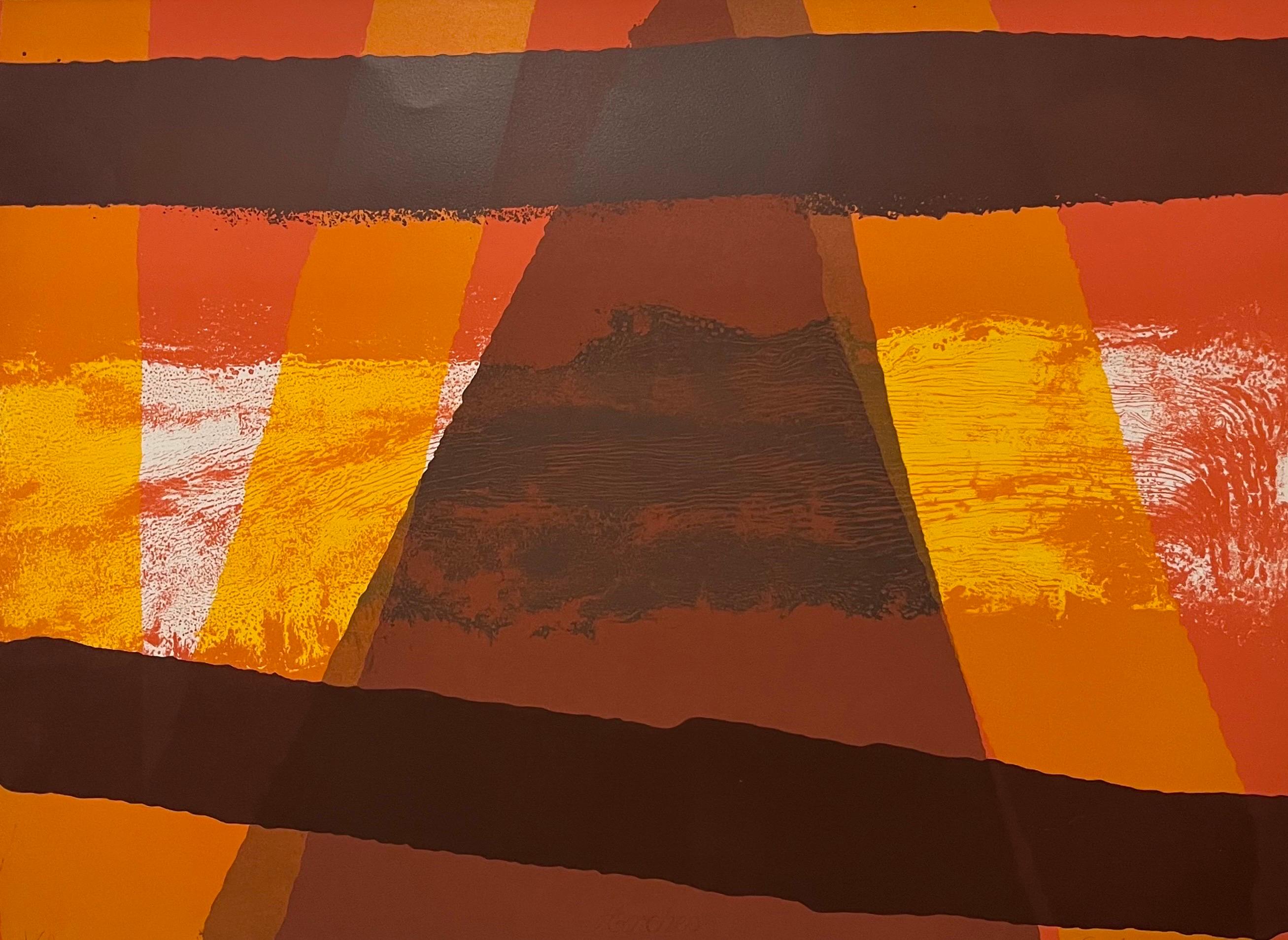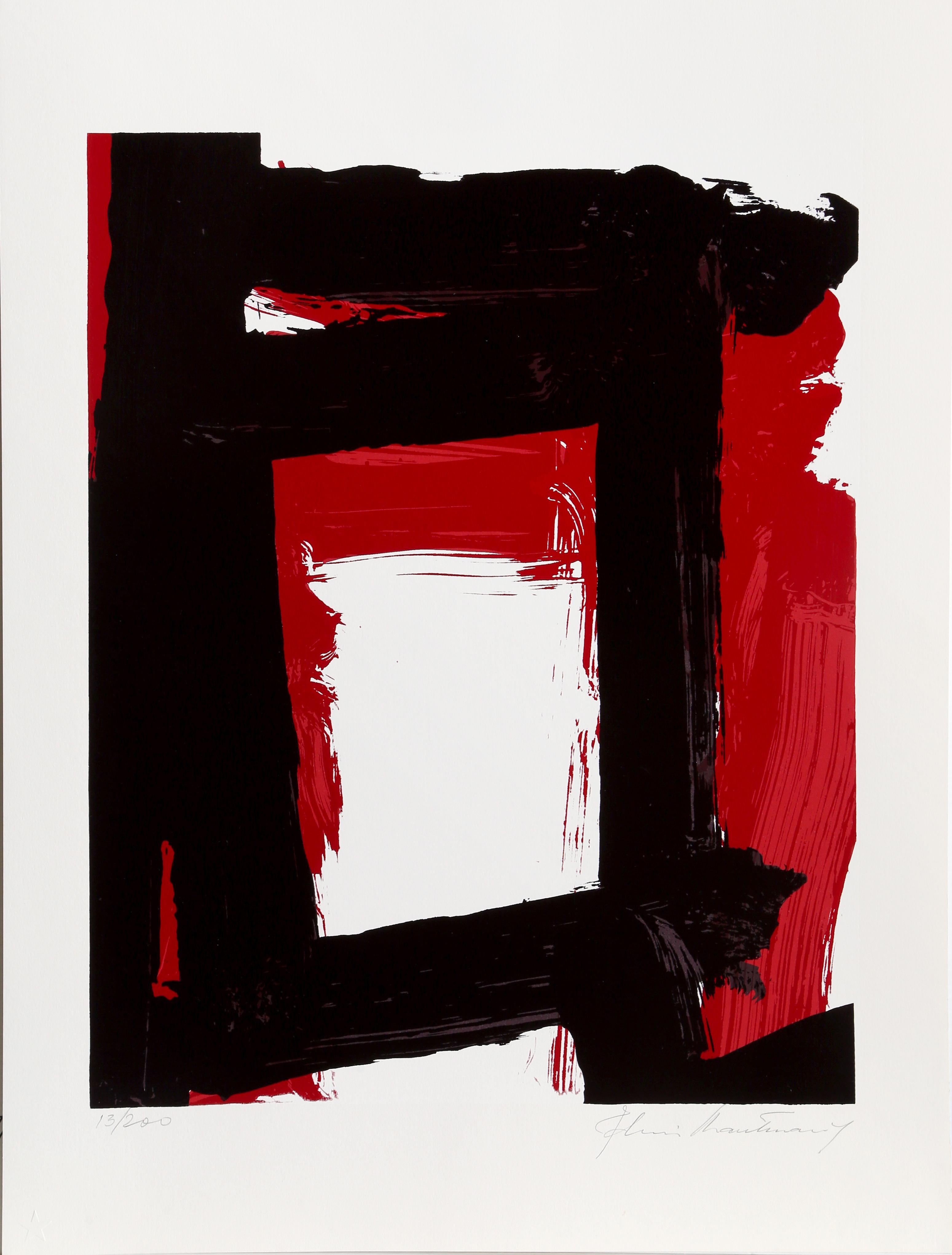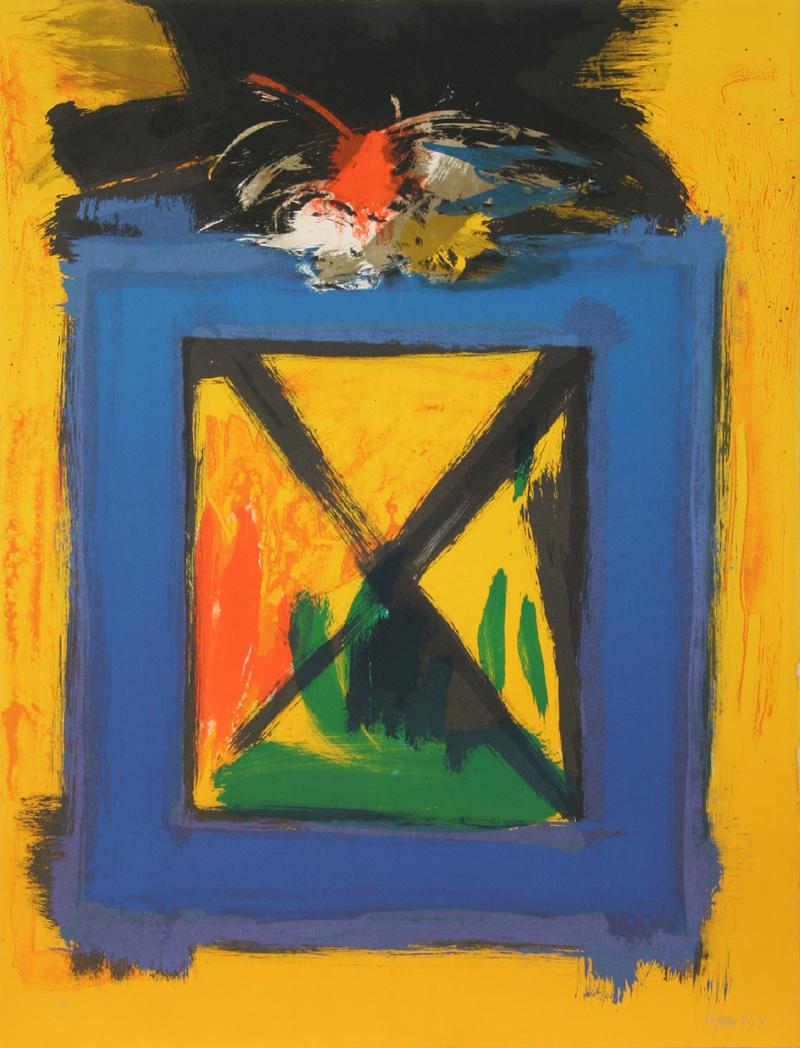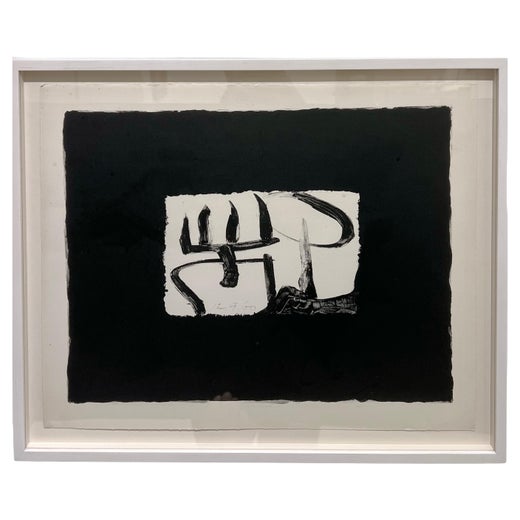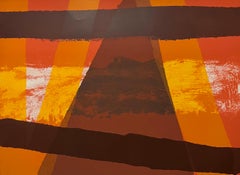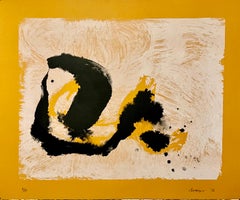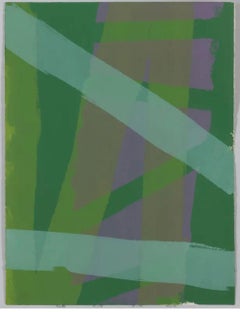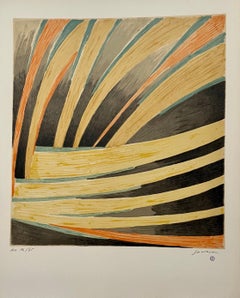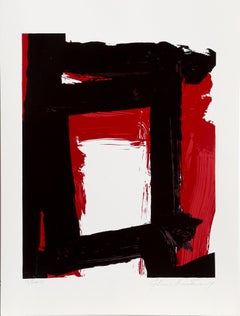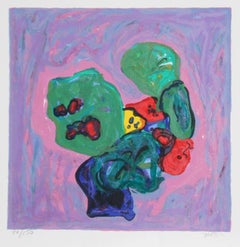Items Similar to Large Silkscreen Abstract Latvian American Modernist Artist - Rosh Hashana
Want more images or videos?
Request additional images or videos from the seller
1 of 10
Adja YunkersLarge Silkscreen Abstract Latvian American Modernist Artist - Rosh Hashana1974
1974
$950
£718.74
€829.54
CA$1,326.89
A$1,475.24
CHF 772.20
MX$18,093.37
NOK 9,832.07
SEK 9,282.64
DKK 6,190.28
Shipping
Retrieving quote...The 1stDibs Promise:
Authenticity Guarantee,
Money-Back Guarantee,
24-Hour Cancellation
About the Item
Red Echo
Adja Yunkers
b. 1900, Riga, Russia; d. 1983, New York
Adja Yunkers was born Adolf Junkers on July 15, 1900, in Riga, Russia (now Latvia). He studied art in Petrograd (now Saint Petersburg), but from 1917 to 1919 his schooling was interrupted by military service in the Russian army. Yunkers soon left Russia for Europe and traveled extensively for the next two decades, settling for long periods in Cuba, France, and Germany. During much of his early career, Yunkers was active in political as well as artistic movements. At times his political investments even outweighed his commitment to his art, and in 1936 he moved to Spain to fight in its civil war. When the war ended in 1939, he moved to Stockholm and began to focus on art making again. He became associated with the Swedish Surrealists and published three journals devoted to art and politics. These handcrafted publications signaled a strong interest in printmaking, and in the 1940s he made many woodblock prints depicting distorted objects and figural compositions that demonstrate the influence of German Expressionism on his work.
In 1947, Yunkers moved to New York and began to teach at the New School for Social Research. After four tumultuous marriages, he married one of his former students from the New School, Dore Ashton, in 1952. Ashton became an art critic for the New York Times in 1955, and through her, Yunkers was introduced to the artists who would become known as the Abstract Expressionists. He began drawing with pastel directly on canvas, resulting in large-scale works that recall Color Field painting in their emphasis on the materiality of color. Expanding on this impulse, Yunkers's later work made extensive use of negative space, collage, and monochrome. The influence of Minimalism in this more reduced aesthetic is clear, and his canvases became more object-like. Both printmaking and bookmaking were central to Yunkers's oeuvre. He founded the Rio Grande Workshop in New Mexico (where he also taught) in 1949, publishing an entirely handmade art magazine called Prints in the Desert. In 1969 he illustrated a limited-edition book by the poet Octavio Paz, a collaboration that sparked both a friendship and a number of additional illustrated books in the years to come. Yunkers also produced two large public works on commission: A Human Condition (1966), a mural for Syracuse University, and a tapestry produced for Stony Brook University (1968), both in New York.
Yunkers had his first solo exhibition in 1921 at the Maria Kunde Galerie, Hamburg, Germany. Later that same year, he was part of a group show featuring Eastern European and Russian artists, including Alexander Archipenko, Marc Chagall, and Vasily Kandinsky, held in Hannover, Germany.
He was included in an exhibition organized by the Print Council of America entitled American Prints Today. A snapshot of the state of American printmaking at the time of the exhibition. Among the many featured artists were Josef Albers, Leonard Baskin, Ralston Crawford, Adolf Dehn, Fritz Glarner, Grace Hartigan, Jasper Johns, Ynez Johnston, John Paul Jones, Misch Kohn, Mauricio Lasansky, Vincent Longo, Ezio Martinelli, James McGarrell, Gabor Peterdi, Karl Schrag, Ben Shahn, Benton Spruance, Carol Summers, and Adja Yunkers. He exhibited widely in the United States and Europe, with retrospectives at the Baltimore Museum of Art (1960); Utah Museum of Art, Salt Lake City (1968); Museo de arte moderno, Bosque de Chapultepec, Instituto nacional de bellas artes, Mexico City (1975); and Fine Arts Museum of Long Island, Hempstead, New York (1984). In 1967, the Brooklyn Museum presented a retrospective devoted entirely to his prints. Yunkers died on December 24, 1983, in New York.
- Creator:
- Creation Year:1974
- Dimensions:Height: 21.8 in (55.38 cm)Width: 25.1 in (63.76 cm)
- Medium:
- Movement & Style:
- Period:
- Condition:Some toning, please see photos.
- Gallery Location:Surfside, FL
- Reference Number:1stDibs: LU38215087412
Adja Yunkers
Adja Yunkers was an American abstract painter and printmaker. He was born in Riga, Governorate of Livonia, Russian Empire in 1900. Yunkers studied art in Leningrad, Berlin, Paris and London. He lived in Paris for 14 years and then moved to Stockholm in 1939. In Stockholm, he published and edited the art magazines ARS magazine and Creation magazine. Yunkers died in New York City in 1983.
About the Seller
4.9
Platinum Seller
Premium sellers with a 4.7+ rating and 24-hour response times
Established in 1995
1stDibs seller since 2014
1,780 sales on 1stDibs
Typical response time: <1 hour
- ShippingRetrieving quote...Shipping from: Surfside, FL
- Return Policy
Authenticity Guarantee
In the unlikely event there’s an issue with an item’s authenticity, contact us within 1 year for a full refund. DetailsMoney-Back Guarantee
If your item is not as described, is damaged in transit, or does not arrive, contact us within 7 days for a full refund. Details24-Hour Cancellation
You have a 24-hour grace period in which to reconsider your purchase, with no questions asked.Vetted Professional Sellers
Our world-class sellers must adhere to strict standards for service and quality, maintaining the integrity of our listings.Price-Match Guarantee
If you find that a seller listed the same item for a lower price elsewhere, we’ll match it.Trusted Global Delivery
Our best-in-class carrier network provides specialized shipping options worldwide, including custom delivery.More From This Seller
View AllMod Abstract Expressionist Modernist Lithograph Edward Avedisian Color Field Art
By Edward Avedisian
Located in Surfside, FL
Edward Avedisian (1936-2007)
Cleo, Fur Queen, 1969
Lithograph in color on Arches wove paper.
Hand signed, dated and numbered in pencil.
Edition 100
Dimensions:
22.25 inches X 30.25...
Category
1960s Abstract Expressionist Abstract Prints
Materials
Lithograph
Lyrical Abstract Expressionist Lithograph Cleve Gray Lithograph Silkscreen Print
By Cleve Gray
Located in Surfside, FL
Cleve Gray, American (1918-2004)
Composition, (1976)
serigraph or lithograph
Hand signed lower right, and editioned 9/50
Dimensions: 19.25 X 23.75 inches sheet.
unframed
Cleve Gray (1918 – 2004) was an American Abstract expressionist painter, who was also associated with Color Field painting and Lyrical Abstraction.
Gray was born Cleve Ginsberg, the family changed their name to Gray in 1936. Gray attended the Ethical Culture School in New York City (1924–1932). From the age of 11 until the age of 14 he had his first formal art training with Antonia Nell, who had been a student of George Bellows. From 15 to 18 he attended the Phillips Academy, in Andover, Massachusetts; where he studied painting with Bartlett Hayes and won the Samuel F. B. Morse Prize for most promising art student. In 1940 he graduated from Princeton University summa cum laude, with a degree in Art and Archeology. He was a member of Phi Beta Kappa. At Princeton he studied painting with James C. Davis and Far Eastern Art with George Rowley, under whose supervision he wrote his thesis on Yuan dynasty landscape painting. Best known for his calligraphic abstractions which melded elements of Abstract Expressionism, Color Field painting, and traditional Chinese scroll painting. After graduation in 1941 Gray moved to Tucson, Arizona. In Arizona he exhibited his modernist landscape paintings and still lifes at the Alfred Messer Studio Gallery in Tucson. In 1942 he returned to New York and joined the United States Army. During World War II, he served in the signal intelligence service in Britain, France and Germany, where he rose to the rank of sergeant. After the liberation of Paris he was the first American GI to greet Pablo Picasso and Gertrude Stein. He began informal art training with the French artists André Lhote and Jacques Villon, continuing his art studies in Paris after the war. Gray returned to the United States in 1946. In 1949 he moved to the house his parents had owned on a 94-acre property in Warren, Connecticut, and lived there for the rest of his life. In the 1960s he formed a close friendship with Barnett Newman. It was during this time that he experienced an artistic metamorphosis, dissolving his earlier cubist compositions in a sea of distilled color. This dramatic body of work marked the beginning of an artistic meditation that would last for over 40 years. The rigors of French modernism, the ethos of Abstract Expressionism and the meditative restraint of Chinese and Japanese scroll painting commingle with astounding affect. The atmospheric, subdued tones of his 1960s paintings gradually gave way to bright, monochromatic fields of color, hazily washed onto the canvas in stain like swathes. Much of his work from the last three decades of his career feature striking graphic brushwork that conjures the influence of Japanese and Chinese calligraphy. He married the noted author Francine du Plessix on April 23, 1957. They worked in separate studios in two outbuildings with a driveway in between. Gray was a veteran of scores of exhibitions throughout his career, as listed below, from the early days Tucson, through to postwar Paris and New York, and most recently in 2002 at the Berry-Hill Gallery in New York City. His paintings are held in the collections of numerous prominent museums and institutions. In 2009 the art critic Karen Wilkin curated a posthumous retrospective of his work at the Boca Raton Museum of Art, Florida, and other posthumous exhibitions have been held.
Museum collections
Addison Gallery of American Art, Phillips Academy, Andover, MA
Albright-Knox Art Gallery, Buffalo, New York
Boca Raton Museum of Art, Boca Raton, Florida
The Brooklyn Museum, New York City
Columbia University Art Gallery, New York City
Columbus Museum of Art, Ohio
The Corcoran Gallery of Art, Washington, D.C.
Grey Art Gallery and Study Center, New York University, New York City
Solomon R. Guggenheim Museum, New York City
Honolulu Museum of Art, Honolulu, Hawaii
The Jewish Museum, New York City
The Metropolitan Museum of Art, New York City
Museum of Art, Rhode Island School of Design, Providence
Museum of Fine Arts, Boston
Museum of Fine Arts, Houston
Museum of Modern Art, New York City
The Neuberger Museum, State University of New York at Purchase
New Britain Museum of American Art, Connecticut
The Newark Museum, New Jersey
Norton Gallery of Art, West Palm Beach, Florida
Oklahoma City Art Center, Oklahoma
The Phillips Collection, Washington, D.C.[14]
The Art Museum, Princeton University, New Jersey[6]
Rose Art Museum, Brandeis University, Waltham, Massachusetts
Sheldon Museum of Art, University of Nebraska, Lincoln
Smithsonian American Art Museum, Washington, D.C.
The Wadsworth Atheneum, Hartford, Connecticut
Whitney Museum of American Art, New York City
Yale University, New Haven, Connecticut
Williams College Museum of Art, Williamstown, Massachusetts
Yale University Art Gallery, New Haven, Connecticut
He was included in the show 1977, Group Exhibition, Betty Parsons Gallery. Mino Argento...
Category
1970s Abstract Expressionist Abstract Prints
Materials
Lithograph
Mod Abstract Expressionist Modernist Lithograph Edward Avedisian Color Field Art
By Edward Avedisian
Located in Surfside, FL
Edward Avedisian (1936-2007)
Green Gold, 1969
Lithograph in color on Arches wove paper.
Hand signed, dated and numbered in pencil.
Edition 100
Dimensions:
22.25 inches X 30.25 inch...
Category
1960s Abstract Expressionist Abstract Prints
Materials
Lithograph
Russian French Avant Garde Lithograph Rhythm in Colour Vibrant Abstract Print
By Léopold Survage
Located in Surfside, FL
Léopold Survage (French/Russian, 1879-1968),
"Rythmes Colorés", 1967-1968
Lithograph on Vélin d'Arches paper, Printed by Mourlot, Paris
Hand signed in pencil and numbered "AN 16/75"...
Category
1960s Abstract Abstract Prints
Materials
Lithograph
Israeli Josef Zaritsky Abstract Modernist Lithograph Print "Composition"
Located in Surfside, FL
Abstract Composition, 1959 Lithograph
This was from a portfolio which included works by Yosl Bergner, Menashe Kadishman, Yosef Zaritsky, Aharon Kahana, Moshe Tamir and Michael Gross.
Joseph (Yossef) Zaritsky (Hebrew: יוסף זריצקי; September 1, 1891 – November 30, 1985) was one of Israel's greatest artists and one of the early promoters of modern art in the Land of Israel both during the period of the Yishuv (Palestine, the body of Jewish residents in the Land of Israel before the establishment of the State of Israel) and after the establishment of the State. In 1948 Zaritsky was one of the founders of the "Ofakim Hadashim" group. In his works he created a uniquely Israeli style of abstract art, which he sought to promote by means of the group. For this work he was awarded the Israel Prize for painting in 1959.
Joseph Zaritsky...
Category
1950s Modern Abstract Prints
Materials
Lithograph
Pietro Consagra Italian Mod Abstract Expressionist Forma Art Informel Lithograph
By Pietro Consagra
Located in Surfside, FL
Pietro Consagra (Italian, 1920-2005).
Hand signed in pencil and numbered limited edition color lithograph on Magnani paper.
Embossed stamp with limited edition numbers in pencil to lower left, and having artist pencil signature to lower right.
(from a limited edition of 80 with 15 artist's proofs)
Published by Stamperia 2RC, Rome Italy and Marlborough Gallery, Rome, Italy.
Abstract Modernist work in colors, produced in the style of the Forma art movement of Postwar Italy, of which the artist was a prominent member.
Pietro Consagra (1920 – 2005) was an Italian Post war artist working in painting, printmaking and sculpture. In 1947 he was among the founding members of the Forma 1 group of artists, proponents of structured abstraction. (similar to the Art Informel and Art Brut in France and the Brutalist artists)
Consagra was born on 6 October 1920 in Mazara del Vallo, in the province of Trapani in south-western Sicily, to Luigi Consagra and Maria Lentini. From 1931 he enrolled in a trade school for sailors, studying first to become a mechanic, and later to become a captain. In 1938 he moved to Palermo, where he enrolled in the liceo artistico; despite an attack of tuberculosis, he graduated in 1941, and in the same year signed up at the Accademia di Belle Arti, where he studied sculpture under Archimede Campini. After the Invasion of Sicily and the Allied occupation of Palermo in 1943, Consagra found work as a caricaturist for the American Red Cross club of the city; he also joined the Italian Communist Party. Early in 1944, armed with a letter of introduction from an American officer, he travelled to Rome. There he came into contact with the Sicilian artist Concetto Maugeri, and through him with Renato Guttuso, who was also Sicilian and who introduced him to the intellectual life of the city and to other postwar artists such as Leoncillo Leonardi, Mario Mafai and Giulio Turcato. Consagra signed up at the Accademia di Belle Arti di Roma in September 1944 and studied sculpture there under Michele Guerrisi, but left before completing his diploma.
In 1947, with Carla Accardi, Ugo Attardi, Piero Dorazio, Mino Guerrini, Achille Perilli, Antonio Sanfilippo and Giulio Turcato, Consagra started the artist's group Forma 1, which advocated both Marxism and structured abstraction.
Steadily Consagra's work began to find an audience. Working primarily in metal, and later in marble and wood, his thin, roughly carved reliefs, began to be collected by Peggy Guggenheim and other important patrons of the arts. He showed at the Venice Biennale eleven times between 1950 and 1993, and in 1960 won the sculpture prize at the exhibition. During the 1960s he was associated with the Continuità group, an offshoot of Forma I, and in 1967 taught at the School of Arts in Minneapolis. Large commissions allowed him to begin working on a more monumental scale, and works of his were installed in the courtyard of the Foreign Ministry in Rome and in the European Parliament, Strasbourg. His work is found in the collections of The Tate Gallery, London, in Museo Cantonale d'Arte of Lugano and the Museum of Modern Art, Paris, and the National Gallery of Art in Washington, D.C..
Consagra returned to Sicily where he sculpted a number of significant works during the 1980s. With Senator Ludovico Corrao, he helped created an open-air museum in the new town of Gibellina, after the older town had been destroyed in the earthquake of 1968. Consagra designed the gates to the town's entrance, the building named "Meeting" and the gates to the cemetery, where he was later buried.
In 1952 Consagra published La necessità della scultura ("the need for sculpture"), a response to the essay La scultura lingua morta ("sculpture, a dead language"), published in 1945 by Arturo Martini. Other works include L'agguato c'è ("the snare exists", 1960), and La città frontale ("the frontal city", 1969). His autobiography, Vita Mia, was published by Feltrinelli in 1980. In 1989 a substantial retrospective exhibition of work by Consagra was shown at the Galleria Nazionale d'Arte Moderna in Rome; in 1993 a permanent exhibition of his work was installed there. In 1991 his work was shown in the Hermitage Museum in St. Petersburg. In 2002 the Galerie der Stadt Stuttgart opened a permanent exhibition of his work. He was one of ten artists invited by Giovanni Carandente, along with David Smith, Alexander Calder, Arnaldo Pomodoro, Lynn Chadwick, and Beverly Pepper, to fabricate works in Italsider factories in Italy for an outdoor exhibition, "Sculture nella città", held in Spoleto during the summer of 1962. He was included in the The 1962 International Prize for Sculpture the jury included Argan, Romero Brest and James Johnson Sweeney the former director of the Solomon R. Guggenheim Museum in New York. The participants included Louise Nevelson and John Chamberlain for the United States; Lygia Clark for Brazil; Pietro Consagra, Lucio Fontana, Nino Franchina, and Gió Pomodoro for Italy; Pablo Serrano for Spain; and Eduardo Paolozzi, William Turnbull, and Kenneth Armitage for England. Gyula Kosice, Noemí Gerstein, Julio Gero, Naum Knop...
Category
1960s Abstract Expressionist Abstract Prints
Materials
Lithograph
You May Also Like
A II, Abstract Expressionist Screenprint by Adja Yunkers
By Adja Yunkers
Located in Long Island City, NY
Artist: Adja Yunkers, American (1900 - 1983)
Title: A II
Year: 1972
Medium: Screenprint, Signed and Numbered in Pencil
Edition: 2/50
Image size 40 x 30 inches
Size: 41 x 31 in. (104....
Category
1970s Abstract Expressionist Abstract Prints
Materials
Screen
Abstract Expressionist Silkscreen by Adja Yunkers 1972
By Adja Yunkers
Located in Long Island City, NY
Artist: Adja Yunkers, Latvian/American (1900 - 1983)
Title: untitled
Year: 1972
Medium: Silkscreen with Embossing, Signed and Numbered in Pencil
Edition: 70
Size: 24.75 x 30 in. (62....
Category
1970s Abstract Expressionist Abstract Prints
Materials
Screen
Abstract Silkscreen by Edvins Strautmanis
By Edvins Strautmanis
Located in Long Island City, NY
Artist: Edvins Strautmanis, Latvian (1933 - )
Title: untitled 1
Year: circa 1980
Medium: Silkscreen, signed and numbered in pencil
Edition: 13/200
Size: 30 x 22 inches (76 x 56cm)
Category
1980s Abstract Expressionist Abstract Prints
Materials
Screen
Signed Abstract Silkscreen by Amos Yaskil
By Amos Yaskil
Located in Long Island City, NY
Untitled - Abstract
Amos Yaskil
Israeli (1935)
Date: circa 2000
Screenprint, signed and numbered in pencil
Edition of 79/150
Size: 18 in. x 16.5 in. (45.72 cm x 41.91 cm)
Category
Early 2000s Abstract Abstract Prints
Materials
Screen
Abstract Lithograph by Rolando De Juan
Located in Long Island City, NY
Abstract Blue Square
Rolando de Juan, Argentine (1931–1989)
Date: 1971
Lithograph, signed and numbered in pencil
Edition of 120
Size: 30 in. x 23 in. (76.2 cm x 58.42 cm)
Category
1970s Abstract Expressionist Abstract Prints
Materials
Lithograph
Colorful Abstract Silkscreen by Raymond Parker
By Raymond Parker
Located in Long Island City, NY
Artist: Raymond Parker, American (1922 - 1990)
Title: Untitled
Year: 1980
Medium: Silkscreen, signed and numbered in pencil
Edition: 70
Size: 23 x 30 inches
Category
1980s Abstract Expressionist Abstract Prints
Materials
Screen
